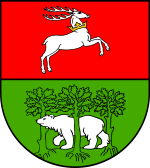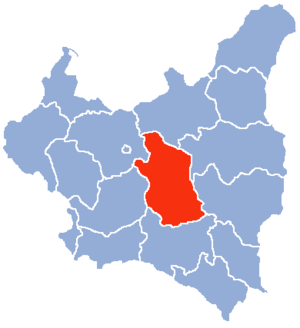.gif)
Lublin Voivodeship (1919-1939)
Encyclopedia
| Wojewodztwo lubelskie | |
| order="0" cellpadding="2" cellspacing="0"> |  |
| (Coat of Arms) |

Lublin Voivodeship was a unit of administrative division of the Second Polish Republic
Second Polish Republic
The Second Polish Republic, Second Commonwealth of Poland or interwar Poland refers to Poland between the two world wars; a period in Polish history in which Poland was restored as an independent state. Officially known as the Republic of Poland or the Commonwealth of Poland , the Polish state was...
, in the years 1919–1939. Its capital and biggest city was Lublin
Lublin
Lublin is the ninth largest city in Poland. It is the capital of Lublin Voivodeship with a population of 350,392 . Lublin is also the largest Polish city east of the Vistula river...
.
Location and area
In the years 1919–1939, Lublin Voivodeship covered central part of Poland, the heartland of the country, bordering Białystok Voivodeship (1919–1939) to the north, Warsaw VoivodeshipWarsaw Voivodeship
Warszawa Voivodeship was a unit of administrative division and local government in Poland in years 1975–1998, superseded by Masovian Voivodeship.Capital city: WarsawMajor cities and towns: :* Warsaw ;...
and Kielce Voivodeship
Kielce Voivodeship
Kielce Voivodeship is a former unit of administrative division and local government in Poland.-1921-1938:Kielce Voivodeship was a unit of administrative division and local government in Poland in years 1921-1939. Back then, it covered a large chunk of central part of the country, including such...
to the west, Lwów Voivodeship
Lwów Voivodeship
Lwów Voivodeship was an administrative unit of interwar Poland . According to Nazis and Soviets it ceased to exist in September 1939, following German and Soviet aggression on Poland . The Polish underground administration existed till August 1944.-Population:Its capital, biggest and most...
to the south and Polesie Voivodeship
Polesie Voivodeship
Polesie Voivodeship was an administrative unit of interwar Poland . It ceased to exist in September 1939, following German and Soviet aggression on Poland .-Population:...
as well as Volhynian Voivodeship to the east. Its area, after April 1, 1938 (see: Territorial changes of Polish Voivodeships on April 1, 1938
Territorial changes of Polish Voivodeships on April 1, 1938
On April 1, 1938, borders of several western and central Voivodeships changed considerably. This included such Voivodeships as Pomerania, Poznan, Warsaw, Lodz, Bialystok, Lublin and Kielce. Pomerania gained most, while Bialystok lost most...
) was 26,555 km². Landscape was flat and hilly in the south, forests covered only 16.6% of the area (with nation's average of 22.2%, as for January 1, 1937).
Population
According to the 1931 Polish census, the population was 2 116 200. Poles made 85.1% of population, JewsJews
The Jews , also known as the Jewish people, are a nation and ethnoreligious group originating in the Israelites or Hebrews of the Ancient Near East. The Jewish ethnicity, nationality, and religion are strongly interrelated, as Judaism is the traditional faith of the Jewish nation...
- 10.5% and Ukrainians
Ukrainians
Ukrainians are an East Slavic ethnic group native to Ukraine, which is the sixth-largest nation in Europe. The Constitution of Ukraine applies the term 'Ukrainians' to all its citizens...
(in the east and south) - 3%. The Jews preferred to live in the cities and towns, especially in Lublin itself. In the whole Voivodeship, 24.6% of population was illiterate (as for 1931).
Industry
The Voivodeship's biggest industrial center was the city of Lublin. Other than that, it lacked significant industry centers. In mid-1930s Polish government started a huge public works program, called Centralny Okręg Przemysłowy, which was a great boost to overpopulated and poor counties. It covered southwestern part of the Voivodeship, with the town of KraśnikKrasnik
Kraśnik is a town in eastern Poland with 37,989 inhabitants , situated in the Lublin Voivodeship. It is the seat of Kraśnik County.-History:First settled in the 13th century, it received its city charter in 1377....
. The railroad density was 4.0 km. per 100 km². (with total length of railroads 1 236 km.).
Cities and administrative divisions
Lublin Voivodeship in mid-1939 consisted of 16 powiats (counties), 29 cities and towns and 228 villages. The counties were:- Biała Podlaska county (area 2 122 km², population 116 000),
- Biłgoraj county (area 1 720 km², population 116 900),
- Chełm county (area 1 975 km², population 162 300),
- HrubieszówHrubieszówHrubieszów is a town in southeastern Poland, with a population of 18,661 . It is the capital of Hrubieszów County. Since 1999 Hrubieszów has been part of Lublin Voivodeship . Earlier, 1975–98, it had been part of Zamość Province...
county (area 1 575 km², population 130 000), - Janów LubelskiJanów LubelskiJanów Lubelski is a town in eastern Poland. It has 11,882 inhabitants .Situated in the Lublin Voivodship . It is the capital of Janów Lubelski County.It has a large hospital...
county (area 1 960 km², population 152 700), - KrasnystawKrasnystawKrasnystaw is a town in eastern Poland with 19,615 inhabitants . Situated in the Lublin Voivodeship , previously in Chelm Voivodeship . It is the capital of Krasnystaw County....
county (area 1 521 km², population 134 200), - LubartówLubartówLubartów is a town in eastern Poland, with 23,000 inhabitants , situated in Lublin Voivodeship. It is the capital of Lubartów County and the Lubartów Commune.-History:...
county (area 1 389 km², population 108 000), - city of LublinLublinLublin is the ninth largest city in Poland. It is the capital of Lublin Voivodeship with a population of 350,392 . Lublin is also the largest Polish city east of the Vistula river...
county (area 30 km², population 112 300), - LublinLublinLublin is the ninth largest city in Poland. It is the capital of Lublin Voivodeship with a population of 350,392 . Lublin is also the largest Polish city east of the Vistula river...
county (area 1 889 km², population 163 500), - Łuków county (area 1 762 km², population 129 100),
- Puławy county (area 1 618 km², population 156 500),
- Radzyń PodlaskiRadzyn PodlaskiRadzyń Podlaski is a town in eastern Poland, about 60 km north of Lublin, with 16,140 inhabitants . Situated in the Lublin Voivodeship , previously in Biała Podlaska Voivodeship . It is the capital of Radzyń Podlaski County.The town was founded in 1468. The most important landmark is the...
county (area 1 621 km², population 99 100), - SiedlceSiedlceSiedlce ) is a city in eastern Poland with 77,392 inhabitants . Situated in the Masovian Voivodeship , previously the city was the capital of a separate Siedlce Voivodeship ....
county (area 1 988 km², population 151 400), - Tomaszów LubelskiTomaszów LubelskiTomaszów Lubelski is a town in south-eastern Poland with 20,261 inhabitants . Situated in the Lublin Voivodeship , previously in Zamość Voivodeship . It is the capital of Tomaszów Lubelski County.-History:...
county (area 1 397 km², population 121 100), - Włodawa county (area 2 326 km², population 113 600),
- ZamośćZamoscZamość ukr. Замостя is a town in southeastern Poland with 66,633 inhabitants , situated in the south-western part of Lublin Voivodeship , about from Lublin, from Warsaw and from the border with Ukraine...
county (area 1 662 km², population 149 500).
According to the 1931 census, biggest cities were:
- Lublin (pop. 112 300),
- Siedlce (pop. 36 900),
- Chełm (pop. 29 100),
- Zamość (pop. 24 700),
- Biała Podlaska (pop. 17 400),
- Miedzyrzec Podlaski (pop. 16 800),
- Łuków (pop. 14 000),
- Hrubieszów (pop. 13 200),
- Kraśnik (pop. 12 200),
- Puławy (pop. 12 100).
Voivodes
- Stanisław Moskalewski 17 November 1919 – 25 October 1926
- Antoni Remiszewski 3 November 1926 – 29 September 1930
- Bolesław Świdziński 29 September 1930 – 30 January 1933 (acting till 1 April 1932)
- Józef Rożniecki 31 January 1933 – 8 September 1937
- Jerzy Albin de Tramecourt 8 September 1937 – 17 September 1939

